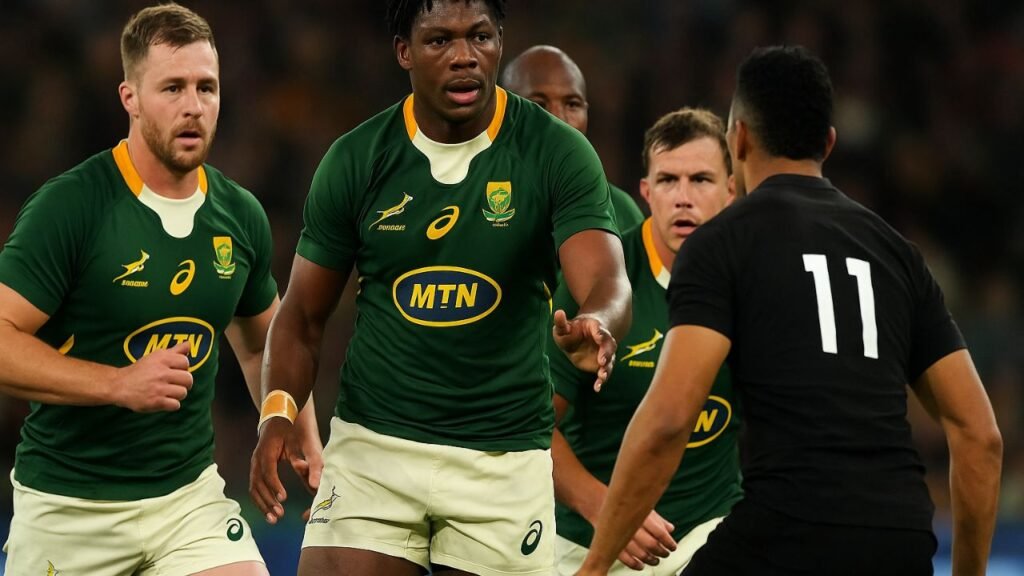Test Rematch With New Zealand – South Africa’s selection committee has lived up to the headline—shaking up the backline for a high-stakes rematch against New Zealand after the 24–17 defeat at Eden Park on 6 September. Head coach Rassie Erasmus has doubled down on his depth-first strategy, promoting emerging talent while demanding cleaner execution and better discipline than in Auckland, where errors proved costly (match details: World Rugby). With the series momentum on the line in Wellington, Erasmus accelerated his team announcement to set the tone early and signal bold intent. The focus is clear: speed in decision-making at 9–10, variety on exit plays, and more width to stress the All Blacks’ defensive edges. It is also an audition for the next World Cup cycle: a chance for new combinations to earn trust while the seasoned core recalibrates. Saturday’s stage—Sky Stadium, Wellington—feels tailor-made for a statement. Fixtures show the rematch scheduled there on 13 September (All Blacks; TRC fixtures).

New-Look Backline: Selection Calls That Change the Picture
At the heart of the shake-up is fly-half Sacha Feinberg-Mngomezulu, whose distribution and attacking kicks should quicken the tempo. He pairs with scrum-half Cobus Reinach to energize ruck-to-ruck speed and contestable kicking lanes. In midfield, Damian Willemse slots at 12 for second-receiver variety, with Canan Moodie at 13 to add strike-running and kick-chase pressure. At the back, Aphelele Fassi’s selection at 15 prioritizes counter-attack and backfield coverage, while rookie Ethan Hooker brings fresh finishing instincts on the wing. The bench mix—Grant Williams, Manie Libbok, and André Esterhuizen—keeps late-game options open: speed to lift tempo, a long kicking game if conditions tighten, and a power carrier to win collisions at 12. Against an All Blacks side brimming with confidence at home (fixtures/results), these calls aim to sharpen decision speed and maximize turnover conversion.
Up Front: Selection Signals and the Balance of Power
Erasmus hasn’t just shuffled the backs. Returning No. 8 Jasper Wiese fortifies the gainline after suspension, while captain Siya Kolisi shifts to blindside to stabilize set-piece lifts and breakdown sequencing alongside Pieter-Steph du Toit. Lineout accuracy and maul control are clear priorities: Lood de Jager replaces Eben Etzebeth to tighten calling and movement, partnering Ruan Nortje. The front row—Ox Nche, Malcolm Marx, Thomas du Toit—suggests a scrum-first posture with a heavy maul threat. Erasmus had hinted he might toggle the 5–3 vs 6–2 bench split depending on weather and tactical needs (Reuters team news), preserving the late-game power surge that defined recent campaigns. In short: win set piece, kick long to contest, and trust the reshaped backline to turn broken-field moments into points in the Rugby Championship crucible.
Why Wellington Matters: Conditions, Psychology, and Momentum
Wellington’s wind patterns and swirling kicks often decide territorial battles, making the Bok back-three selections pivotal. With Fassi’s aerial range and Erasmus’ emphasis on contestables, expect more depth in kick coverage, reverse-field exits, and surprise counter-punches. Psychologically, the quick turnaround after Eden Park—documented on ESPN’s match brief—can be a hidden advantage: minimal time to stew on errors, maximal time to reset structures and roles. The All Blacks’ home rhythm is undeniable (fixtures/results), but Wellington is a different tactical puzzle than Auckland. Slowing New Zealand’s quick-tap tempo, denying clean launch ball off lineouts, and manipulating backfield maps with angled kicks could flip the narrative. The Springboks have framed this as a performance standard test as much as a scoreboard mission—process metrics must improve for the result to follow.
Key Battlegrounds and What to Watch in the Rematch
First, breakdown velocity: Reinach’s tempo only bites if cleaners arrive on time; watch Kolisi/du Toit set the ruck floor so Feinberg-Mngomezulu can play flat. Second, aerial duels: expect a spike in contestables and cross-kicks toward Hooker’s edge (FloRugby), designed to force back-three reshuffles. Third, maul discipline: Marx’s direction plus de Jager’s calling must bank penalties and red-zone control. Fourth, bench impact: Williams and Libbok change gear profiles late (team sheet), while Esterhuizen offers contact security if New Zealand flood the 10–12 channel. Finally, context: the Rugby Championship table and travel load make this a momentum hinge (tournament guide). A composed, field-position game with targeted ambition—not reckless width—will define whether the “shake-up” reads as a masterstroke or a learning bet when the whistle blows at Sky Stadium, Wellington.








